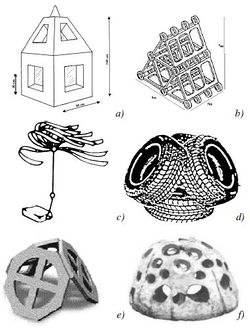Difference between revisions of "Artificial reefs"
| Line 14: | Line 14: | ||
| + | [[Image:ArtificialReefUnits.jpg|thumb|right|250px]] | ||
===Reef units=== | ===Reef units=== | ||
Reef units of different shapes and constructive characteristics can also be used to construct ARs. Particularly in Japan (O’Leary, 2001<ref name="OL">O’Leary, Hubbard T., O’Leary D. Artificial Reefs Feasibility Study, Coastal Resources Centre National University of Ireland Cork, 2001</ref>) these units have a huge popularity and their development is growing. Their macro-roughness induces the dumping of the incident wave agitation above the reef, creating local turbulence and vortices. Usually they are made by steel, reinforced or pre-stressed concrete, fibreglass or a variety of composite materials. These units are produced individually on shore and transported to the staging area. Here they could be combined in a variety of configurations thus allowing adjustment to local conditions and needs. Most of the units are designed to provide nursery areas for fish, to permit a good water recirculation, promote current deflections and marine colonization (O’Leary, 2001<ref name="OL"/>). It is very difficult to provide a catalogue of all shapes and materials employed to realize reef units, because the variety of them is | Reef units of different shapes and constructive characteristics can also be used to construct ARs. Particularly in Japan (O’Leary, 2001<ref name="OL">O’Leary, Hubbard T., O’Leary D. Artificial Reefs Feasibility Study, Coastal Resources Centre National University of Ireland Cork, 2001</ref>) these units have a huge popularity and their development is growing. Their macro-roughness induces the dumping of the incident wave agitation above the reef, creating local turbulence and vortices. Usually they are made by steel, reinforced or pre-stressed concrete, fibreglass or a variety of composite materials. These units are produced individually on shore and transported to the staging area. Here they could be combined in a variety of configurations thus allowing adjustment to local conditions and needs. Most of the units are designed to provide nursery areas for fish, to permit a good water recirculation, promote current deflections and marine colonization (O’Leary, 2001<ref name="OL"/>). It is very difficult to provide a catalogue of all shapes and materials employed to realize reef units, because the variety of them is | ||
Revision as of 12:47, 14 July 2011

|
Contents
Introduction
An artificial reef (AR) is a man-made submerged structure whose main goal is to reduce incident waves by inducing wave breaking. However ARs are often constructed as multipurpose structures, i.e. not only to defend the coast from erosion but also to maximise secondary objectives such as to improve spot surfability, to stabilize nourishment material and to create marine parks of increased biodiversity. Since different aims, materials and configurations as well as site dependent factors are to be considered, design criteria for this structures are not easy to be defined a priori.
Materials
Stones
Stones are used especially for rubble mound structures whose hydraulic stability is verified through the formulae available in literature for low-crested structures (Burcharth et al., 2007 [1]).Un-corrected design of the structure (and thus a wrong selection of stone size) causes a low efficiency of the AR. Structure reshaping induced by wave breaking over the reef may occur and produce instability, with stones rolling down from the structure. Stones are relatively cheaper than other materials but can be more dangerous for surfing safety.
Geobags, geotextile sand containers and geotubes
Geotubes consist of sacks made by geotextile that are filled with sand or gravel. They are characterized by a length and diameter of 20 and 3 m respectively and are particularly recommended for deep bottoms (Matteotti et al., 2003[2]). Geotextile sand containers (GSCs) and geobags are very similar to geotubes, although their dimensions are smaller than that ones and thus are usually adopted at lower depths. The cost of a reef made of GSCs is usually greater than in case of other materials because it’s more difficult the placement. GSCs and geobags are often employed as revetments or as seaward slopes of nearshore structures. It has to be highlighted that exhaustive analysis regarding element stability are not available and therefore it is need to combine numerical and physical models with practice and experience in the field to establish the real stability of the GSC.
Reef units
Reef units of different shapes and constructive characteristics can also be used to construct ARs. Particularly in Japan (O’Leary, 2001[3]) these units have a huge popularity and their development is growing. Their macro-roughness induces the dumping of the incident wave agitation above the reef, creating local turbulence and vortices. Usually they are made by steel, reinforced or pre-stressed concrete, fibreglass or a variety of composite materials. These units are produced individually on shore and transported to the staging area. Here they could be combined in a variety of configurations thus allowing adjustment to local conditions and needs. Most of the units are designed to provide nursery areas for fish, to permit a good water recirculation, promote current deflections and marine colonization (O’Leary, 2001[3]). It is very difficult to provide a catalogue of all shapes and materials employed to realize reef units, because the variety of them is huge. Although, some examples are shown in Figure 1.
Geometry
Layout
Cross-section
Dimensions
Function
See also
References
- ↑ Burcharth, H. F., Hawkins, S., Zanuttigh, B., and Lamberti, A., 2007. Environmental Design Guidelines for Low Crested Coastal Defence Structures, Elsevier.
- ↑ Matteotti G., Ruol P., 2003. L’impiego dei geosintetici nelle opere di ingegneria marittima e costiera, 2003 [1]
- ↑ 3.0 3.1 O’Leary, Hubbard T., O’Leary D. Artificial Reefs Feasibility Study, Coastal Resources Centre National University of Ireland Cork, 2001
Please note that others may also have edited the contents of this article.
|
